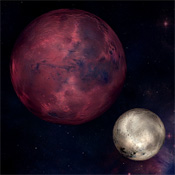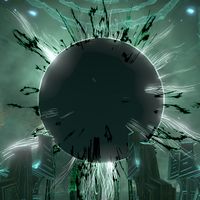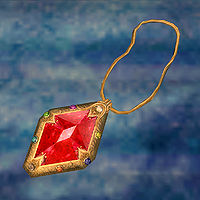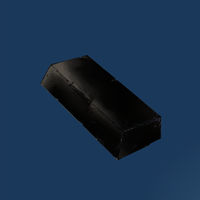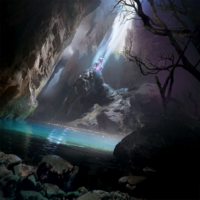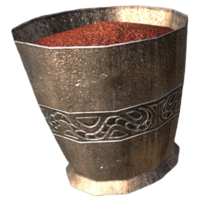Lore:Lorkhan
| Lorkhan | |||
|---|---|---|---|
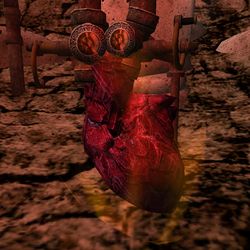 The Heart of Lorkhan |
|||
| Type | God, Aedra, or Daedric Prince | ||
| Realm | Nirn, Sovngarde, Moons, The Serpent | ||
| Pantheon | Nordic Pantheon Khajiit Pantheon Aldmeri Pantheon Dunmeri Pantheon Cyrodilic Pantheon Yokudan Pantheon Argonian Pantheon Reachmen Pantheon Breton Pantheon Ayleid Pantheon |
||
| Sphere | Space,[UOL 1] Mortals,[1] Change[2] | ||
Lorkhan, the Missing God, is the Creator-Trickster-Tester deity present in every Tamrielic mythic tradition.[3] He is known as the Spirit of Nirn, the god of all mortals.[1] His most popular name is the elven variant Lorkhan, or Doom Drum,[3] which sometimes appears as LKHAN[4] or LHKAN.[5] Names for versions or aspects of Lorkhan include Lorkhaj (the Moon Beast) in Elsweyr,[6] and Lorkh, the Spirit of Man, the Mortal Spirit, or the Sower of Flesh among the Reachmen.[7] He is recognized as Sep in Hammerfell, Sheor in High Rock, Shor in Skyrim, and Shezarr in Cyrodiil.[8] To the Altmer, he is also called the Corpse-God.[9] He convinced or contrived the Original Spirits (et'Ada) to bring about the creation of the Mundus, upsetting the status quo—much like his (figurative) father Padomay is usually credited for introducing instability, and hence possibility for creation, into the undivided universe (or the Beginning Place).[3][8][10]
After the world materialized, myths hold that Lorkhan was killed, mutilated, or at least separated from his divine center, the Heart of Lorkhan (known as Sep's "hunger" to the Redguards and Shor's Heart to the Nords), in an event sometimes called the shattering of Lorkhan.[3][8][11] This separation, which purportedly took place in Tamriel,[12] is typically called a punishment, but stories often suggest Lorkhan submitted to it voluntarily.[3][13] Whatever remained of Lorkhan afterward was exiled to wander through creation.[3][10][14] As the impetus for creating the Mundus, Lorkhan is at the center of the great ideological schism between the elven and human perspectives on the event, which is known as the Sundering to the elves, and thus opinions of him vary dramatically in Tamriel.[3] Some wish to return to the spirit realm. To them Nirn is a prison, an illusion to escape, and Lorkhan is the demon that hinders their way. Others think Lorkhan created a testing ground for transcendence, with true escape now possible.[1]
Lorkhan is sometimes associated with the number 9,[15] and has been referred to as the Missing Sibling or Missing Ninth to the Eight Divines.[16][17][UOL 2]
Worship and History[edit]
Lorkhan lived and died in the Dawn.[10] The War of Manifest Metaphors is believed to render this era mostly incapable of supporting a narrative,[18] so constructing one is absurd.[19] This hasn't stopped people from eventually picking their favorite Lorkhan stories and assigning some motivation to him. However, the truth is as elusive as Lorkhan himself,[18] and all associate Lorkhan with trickery.[8][20]
The Theory of the Lunar Lorkhan holds the twin moons Masser and Secunda are Lorkhan's "Flesh-Divinity"—his literal corpse. It says that, like the Aedra, he was a planet (or plane) that participated in creation, but his planet split and his divine spark fell to Nirn "to impregnate it with the measure of its existence and a reasonable amount of selfishness". The moons thus represent the "Cloven Duality", or dichotomy of opposites, that is central to the Tamrielic dialogue on Lorkhan.[18] Both modern and ancient Khajiiti religion places the two moons as separate entities that existed prior to Lorkhan's punishment at Convention,[6] and only believe that the third moon, the Dark Moon, is his corpse.[21][22][23]
In legends, Lorkhan is almost always an enemy of the ancient Aldmer and, therefore, a hero of early mankind.[8] Some Nordic myths state he vowed the Dwemer would "die by [his] hand" shortly before their disappearance at the climax of the War of the First Council circa 1E 700. One even claims that he was briefly reunited with his Heart and mortally wounded Nerevar before being defeated again.[24]
To the Altmer, Lorkhan (who they view as more a limit than a nature) is the most unholy of all higher powers, as they believe he forever broke their connection to the spirit plane.[1][3][8][20] After many battles, where much elven land was lost, Trinimac knocked Lorkhan down in front of his army and reached in "with more than hands" to remove his Heart.[3] Auriel slew Lorkhan atop the Adamantine Tower after the latter was judged, but his Heart proved indestructible.[3][10][25] It merely laughed, saying, "This Heart is the heart of the world, for one was made to satisfy the other".[3]
In contrast, Dunmeri culture, especially under Tribunal rule, always had a close relationship with the Missing God. Their legends say Boethiah's 'creation' of the Chimer was done with Lorkhan in mind, as the Chimer were to pledge themselves to the 'Frame-Maker'.[26] Lorkhan's Heart would become the source of the Tribunal's divinity, with Lorkhan and his motivations becoming a pondered topic in the Lessons of Vivec. The scarab, the Dunmeri symbol for Lorkhan,[26] is in the symbol of House Redoran.[27] While the Dunmer acknowledge Nirn is a cruel place full of mental anguish, they are among those who believe Lorkhan created a realm where true escape is now finally possible.[1][UOL 3][8][28]
Mankind's opinions on Lorkhan are also divided. Nords revere the heroic Shor, the trickster god who wielded his clever magic to create their afterlife of Sovngarde,[29] and who died to bring about the current world.[30] He is known as the Fox in their totemic pantheon.[31] His widow is the warrior goddess Kyne, the purported creator of mankind and leader of the gods after Shor's demise.[8][30] Imperials have a similarly favorable view of their variation of Shor, also known in Nibenay as Shezarr.[16]
The Bretons of High Rock view Sheor with utter contempt. He is the Bad Man responsible for all strife. Most theologians agree Sheor was conceived following the fall of Saarthal as a demonized version of Shor in High Rock, though he seems to have started as simply a god of crop failure.[8] Redguard legends also paint Lorkhan as adversarial. Their version, Sep, was driven mad by the Hunger of Satakal, and convinced the other gods to create a 'shortcut' for the Walkabout to the Far Shores, but this shortcut—the mortal world—instead put the Far Shores beyond their reach. Though punished for his actions by Tall Papa, Sep continues to exist as a shadow of his former self, attempting to prevent mortal souls from reaching the Far Shores after death.[3]
The Khajiit and Reachmen both credit Namira with having some influence in his actions in creating Nirn. Ancient Khajiit texts that predate the Riddle'Thar Epiphany speak of Lorkhaj surviving the event known as the Convention where his Heart was torn out, allowing him to flee to Azurah with the hole in his chest. Azurah saw Namiira was dwelling within his wound, keeping him alive and corrupting him by imitating his Heart. Azurah cleansed Lorkhaj of the corruption and flung his Dark Heart into the Void, and Lorkhaj perished within Azurah's embrace.[32] From the Dark Heart came the twisted shade of Lorkhaj known as the Moon Beast, first of the dro-m'Athra. And so Lorkhaj represents the duality of Khajiiti souls and their susceptibility towards the spiritual corruption of the Bent Dance.[33][34]
The Reachfolk creation story speaks of Lorkh having an epiphany when he visited the darkness: what is perceived as nothingness is ripe for possibility.[35] And so, Lorkh approached Namira and convinced her to grant him a place in the infinite void to create a realm for wayward spirits, but it was not without a cost. Lorkh sacrificed himself to create a harsh realm, one that is unforgiving and intended to teach through suffering.[7] What happened after is shrouded in the allegory, though following Nirn's creation, darkness was emitted from Lorkh's Heart as a result of his sundering.[36] And so to the Reachmen, Lorkh serves as an example to fight against the darkness in their hearts.[37]
Legacy[edit]
After Lorkhan was slain, Auri-El is said to have lashed his Heart to an arrow and launched it across the world from atop the Adamantine Tower.[25] As it passed over the Heartlands of Cyrodiil, Lorkhan's crystallized blood fell to the ground, which the Ayleids found and used to fashion the Chim-el Adabal.[38] The Heart fell to the ground in modern-day Morrowind, forming a volcano,[3] Red Mountain. The Dwemer eventually found and tried to exploit it, leading to the disappearance of their race from the face of Nirn.[39]
According to Orc and Chimer creation myths, Boethiah took exception to the lies being spread by the elven gods about Lorkhan, most especially those espoused by Trinimac. He defeated Trinimac and took on his form to spread "the truth of Lorkhan's test", the Tri-Angled Truth, and persuaded the followers of Boethiah and Trinimac to abandon Altmeri society.[40][41] Boethiah and Mephala showed them the rules of Psijic Endeavor, a process championed by Saint Veloth and Vivec by which mortals may equal or surpass the gods that created them (the stated purpose of the Mundus),[3][5][42] which may be the "truth of Lorkhan's test" referred to in legend.[8][43] Lorkhan is still associated with the Psijic Endeavor in Morrowind.[8]
Lorkhan has obscure relationships with other deities. He and Akatosh are the only deities who seem to be present in every tradition. Some legends say that Kynareth was the first to agree to his idea for a mortal realm. Mara is sometimes considered his wife or concubine, as is Kynareth (or Kyne). Sheogorath is said to have been created when Lorkhan's divine spark was removed from the world. While Lorkhan is the god of all mortals, Arkay is known as the Mortals' God, and did not come into being before the creation of the mortal world.[8] Lorkhan is sometimes associated with Sithis,[4] "the Void", who is worshipped by members of the Dark Brotherhood. It is thought that Lorkhan may still act in Mundus through the being called the Shezarrine.[44]
Cults devoted to Lorkhan (or his aspects) have long existed in Tamriel. One cult may have predicted the rise of Tiber Septim.[45] These cults proliferated in the late Third Era, and they are associated with spreading the understanding of the Dragon Break phenomenon (though their work is looked down upon in some scholarly circles).[46][47][48] Mankar Camoran claimed that Lorkhan is a Daedra whose Daedric plane is "Dawn's Beauty ... misnamed Tamriel by deluded mortals".[49]
Ebony is an extremely hard, durable, black glass-like substance said to be the crystallized blood of a god or gods,[50][51] Lorkhan in particular.[52] Skyshards and Sky Prisms are a rare type of meteoric glass. Sometimes called "Shards of Aetherius", skyshards are shards of Aetherial magicka that carry the essence of Nirn. They are sometimes linked to Lorkhan.[53] It is believed among the Nords that Nirncrux is another form of the blood of Shor.[54] Orc followers of Trinimac their armors and weapons with polished ebony in token of Lorkhan's blood when Trinimac tore out his Heart.[52]
Gallery[edit]
See Also[edit]
Aspects[edit]
Books[edit]
- The Arcturian Heresy by The Underking, Ysmir Kingmaker — A brief, undated, early historical document covering the Underking and Tiber Septim
- Five Songs of King Wulfharth — A summary of five epic songs of the Ash King, plus an apocryphal song of the Tribunal, Dagoth-Ur and Nerevar
- The Lunar Lorkhan by Fal Droon — A theory about the moons Masser and Secunda
- The Monomyth — A theological book containing the common creation myths
- Sithis — Text detailing an apparent connection between Sithis and Lorkhan
- Spirit of Nirn, God of Mortals — Opinions of the god Lorkhan and the origin of creation
- Varieties of Faith... by Brother Mikhael Karkuxor of the Imperial College — An expansive list of the pantheons and associated divine spirits of Tamriel's dominant cultures
- Varieties of Faith in Tamriel by Brother Mikhael Karkuxor of the Imperial College — Description of the pantheons of gods in Tamriel
Notes[edit]
- In a discussion about the Six Walking Ways, developer Michael Kirkbride presented the following list. These are all various names or titles associated with Tiber Septim, Zurin Arctus, and Wulfharth.[UOL 2]
- 1. Wulfharth L
- 2. Hjalti O
- 3. Ysmir R
- 4. Talos K
- 5. Arctus H
- 6. Septim A
- N
References[edit]
- ^ a b c d e Spirit of Nirn, God of Mortals
- ^ Mankar Camoran's dialogue in Oblivion
- ^ a b c d e f g h i j k l m n The Monomyth
- ^ a b Sithis
- ^ a b The 36 Lessons of Vivec — Vivec
- ^ a b Words of Clan Mother Ahnissi — Clan Mother Ahnissi
- ^ a b Great Spirits of the Reach: Volume 5 — Vashu gra-Morga, Chief Daedrotheologist at the University of Gwylim
- ^ a b c d e f g h i j k l Varieties of Faith... — Brother Mikhael Karkuxor of the Imperial College
- ^ Folly of Man
- ^ a b c d Before the Ages of Man — Aicantar of Shimerene
- ^ Songs of the Return, Vol 7
- ^ Mysterious Akavir
- ^ Plan to Defeat Dagoth Ur — Vivec
- ^ Aedra and Daedra
- ^ 36 Lessons of Vivec, Sermon 29 — Vivec
- ^ a b Shezarr and the Divines — Faustillus Junius
- ^ The Exclusionary Mandates
- ^ a b c The Lunar Lorkhan — Fal Droon
- ^ Den of Lorkhaj loading screen text in ESO
- ^ a b The Arcturian Heresy — The Underking, Ysmir Kingmaker
- ^ Moon Bishop Hunal Answers Your Questions — Moon Bishop Hunal
- ^ The Moon Cats and their Dance — Clan Mother Ahnissi
- ^ Shazah's dialogue in ESO
- ^ Five Songs of King Wulfharth
- ^ a b Tower of Adamant — Hrerm House-builder, Bards College, Solitude
- ^ a b 36 Lessons of Vivec, Sermon 10 — Vivec
- ^ The Crest of House Redoran
- ^ 36 Lessons of Vivec, Sermon 33 — Vivec
- ^ The Road to Sovngarde
- ^ a b Divines and the Nords — High Priest Ingurt
- ^ Ebony Fox Totem Antiquity codex entries in ESO: Greymoor
- ^ The Favored Daughter of Fadomai — Amun-dro, the Silent Priest
- ^ The Sky Spirits — Amun-dro, the Silent Priest
- ^ The Dark Spirits — Amun-dro, the Silent Priest
- ^ The Dark Descent's loading screen in ESO
- ^ Nchuand-Zel's loading screen in ESO
- ^ Ardanir's dialogue in ESO
- ^ Aurbic Enigma 4: The Elden Tree — Beredalmo the Signifier
- ^ The Battle of Red Mountain — Vivec
- ^ The Changed Ones
- ^ The Fall of Trinimac — The Faithless One
- ^ Where Were You ... Dragon Broke — Various
- ^ The Anticipations — Anonymous
- ^ The Song of Pelinal
- ^ Pocket Guide to the Empire, 1st Edition: Morrowind — Imperial Geographical Society, 2E 864
- ^ The Dragon Break Re-Examined — Fal Droon
- ^ Pocket Guide to the Empire, 3rd Edition: The Throat of the World: Skyrim — Imperial Geographical Society, 3E 432
- ^ The Seed — Marobar Sul
- ^ Events of Oblivion
- ^ Raw Ebony dialogue in Morrowind
- ^ Hrorvild Blackrock, Nord weaponsmith — Hrorvild Blackrock
- ^ a b Crafting Motif 22: Trinimac Style — the Venerable Uugus, Priest of Trinimac
- ^ Soul Shriven in Coldharbour quest in ESO
- ^ Rena Hammerhands' dialogue in ESO
Note: The following references are considered to be unofficial sources. They are included to round off this article and may not be authoritative or conclusive.
| |||||||||||||||||||||||||||||||
| |||||||||||
| |||||||||||||||||||||||
| ||||||||||||||||||||||||||
